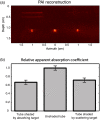Photoacoustic imaging on its way toward clinical utility: a tutorial review focusing on practical application in medicine
- PMID: 37304059
- PMCID: PMC10249868
- DOI: 10.1117/1.JBO.28.12.121205
Photoacoustic imaging on its way toward clinical utility: a tutorial review focusing on practical application in medicine
Abstract
Significance: Photoacoustic imaging (PAI) enables the visualization of optical contrast with ultrasonic imaging. It is a field of intense research, with great promise for clinical application. Understanding the principles of PAI is important for engineering research and image interpretation.
Aim: In this tutorial review, we lay out the imaging physics, instrumentation requirements, standardization, and some practical examples for (junior) researchers, who have an interest in developing PAI systems and applications for clinical translation or applying PAI in clinical research.
Approach: We discuss PAI principles and implementation in a shared context, emphasizing technical solutions that are amenable to broad clinical deployment, considering factors such as robustness, mobility, and cost in addition to image quality and quantification.
Results: Photoacoustics, capitalizing on endogenous contrast or administered contrast agents that are approved for human use, yields highly informative images in clinical settings, which can support diagnosis and interventions in the future.
Conclusion: PAI offers unique image contrast that has been demonstrated in a broad set of clinical scenarios. The transition of PAI from a "nice-to-have" to a "need-to-have" modality will require dedicated clinical studies that evaluate therapeutic decision-making based on PAI and consideration of the actual value for patients and clinicians, compared with the associated cost.
Keywords: clinical translation; photoacoustic imaging; quantitative imaging; systems engineering.
© 2023 The Authors.
Figures

















Similar articles
-
Photoacoustic Imaging in Tissue Engineering and Regenerative Medicine.Tissue Eng Part B Rev. 2020 Feb;26(1):79-102. doi: 10.1089/ten.TEB.2019.0296. Epub 2020 Jan 14. Tissue Eng Part B Rev. 2020. PMID: 31854242 Free PMC article. Review.
-
Deep learning in photoacoustic imaging: a review.J Biomed Opt. 2021 Apr;26(4):040901. doi: 10.1117/1.JBO.26.4.040901. J Biomed Opt. 2021. PMID: 33837678 Free PMC article. Review.
-
The emerging role of photoacoustic imaging in clinical oncology.Nat Rev Clin Oncol. 2022 Jun;19(6):365-384. doi: 10.1038/s41571-022-00615-3. Epub 2022 Mar 23. Nat Rev Clin Oncol. 2022. PMID: 35322236 Review.
-
Recent Advances in Contrast-Enhanced Photoacoustic Imaging: Overcoming the Physical and Practical Challenges.Chem Rev. 2023 Jun 14;123(11):7379-7419. doi: 10.1021/acs.chemrev.2c00627. Epub 2023 Jan 16. Chem Rev. 2023. PMID: 36642892 Review.
-
Simultaneous photoacoustic and ultrasound imaging: A review.Ultrasonics. 2024 Apr;139:107277. doi: 10.1016/j.ultras.2024.107277. Epub 2024 Feb 28. Ultrasonics. 2024. PMID: 38460216 Review.
Cited by
-
Multifunctional gold nanoparticles for cancer theranostics.3 Biotech. 2024 Nov;14(11):267. doi: 10.1007/s13205-024-04086-4. Epub 2024 Oct 14. 3 Biotech. 2024. PMID: 39416669 Review.
-
Quantitative photoacoustic imaging using known chromophores as fluence marker.Photoacoustics. 2024 Dec 19;41:100673. doi: 10.1016/j.pacs.2024.100673. eCollection 2025 Feb. Photoacoustics. 2024. PMID: 39830068 Free PMC article.
-
Anthropomorphic tissue-mimicking phantoms for oximetry validation in multispectral optical imaging.J Biomed Opt. 2025 Jul;30(7):076006. doi: 10.1117/1.JBO.30.7.076006. Epub 2025 Jul 17. J Biomed Opt. 2025. PMID: 40678081 Free PMC article.
-
Photoacoustic imaging for cutaneous melanoma assessment: a comprehensive review.J Biomed Opt. 2024 Jan;29(Suppl 1):S11518. doi: 10.1117/1.JBO.29.S1.S11518. Epub 2024 Jan 12. J Biomed Opt. 2024. PMID: 38223680 Free PMC article.
-
Quantum Dot-based Bio-conjugates as an Emerging Bioimaging Tool for Cancer Theranostic- A Review.Curr Drug Targets. 2024;25(4):241-260. doi: 10.2174/0113894501283669240123105250. Curr Drug Targets. 2024. PMID: 38288834 Review.
References
-
- Duck F. A., Physical Properties of Tissues: A Comprehensive Reference Book, Elsevier Science & Technology, Jordan Hill, United Kingdom: (1990).
-
- Laufer J., et al. , “Quantitative spatially resolved measurement of tissue chromophore concentrations using photoacoustic spectroscopy: application to the measurement of blood oxygenation and haemoglobin concentration,” Phys. Med. Biol. 52(1), 141–168 (2007).PHMBA710.1088/0031-9155/52/1/010 - DOI - PubMed

